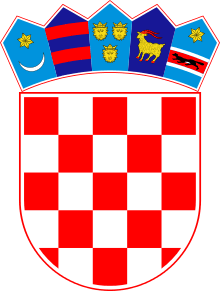Battle of Gorjani
The Battle of Gorjani (Croatian: Bitka kod Gorjana, German: Schlacht bei Gorjani) or Battle of Đakovo (Hungarian: Diakovári csata) was a battle fought on 9 October 1537 at Gorjani, a place in present-day Slavonia (today in eastern Croatia), between the towns of Đakovo and Valpovo, as part of the Little War in Hungary as well as the Hundred Years' Croatian–Ottoman War.
| Battle of Gorjani (1537) | |||||||
|---|---|---|---|---|---|---|---|
| Part of the Little War in Hungary and Hundred Years' Croatian–Ottoman War and Katzianer's Campaign | |||||||
| |||||||
| Belligerents | |||||||
|
|
| ||||||
| Commanders and leaders | |||||||
|
Johann Katzianer Ludwig Lodron † Pavle Bakić † | Semendireli Mehmed Pasha (Governor of Belgrade) | ||||||
| Strength | |||||||
| ~24,000 | 8,000 | ||||||
| Casualties and losses | |||||||
| 20,000 killed | very little | ||||||
Background
After seven years of war and the failed Siege of Vienna in 1529, the Treaty of Konstantiniyye was signed, in which John Zápolya was recognized by the Austrians as King of Hungary as an Ottoman vassal, and the Ottomans recognized Habsburg rule over Royal Hungary.
This treaty satisfied neither John Zápolya nor Austrian Archduke Ferdinand, whose armies began to skirmish along the borders. Ferdinand decided to strike a decisive blow in 1537 at John, thereby violating the treaty.
Battle
Ferdinand sent an army of 24,000 men (from Austria, Hungary, Holy Roman Empire, Bohemia, Tyrol, and Croatia) under the command of the Carniolan nobleman Johann Katzianer to take Osijek.[1]
The siege came to nothing and because of the appearance of the Ottoman cavalry sent by the governor of Belgrade,[1] the army had to withdraw. The Ottoman army reached the Austrians near the swamps of Gorjani, near Đakovo and Valpovo on the Drava river. The imperials were severely defeated and Katzianer fled with the cavalry and abandoned his army. The entire force was annihilated.[1]
A reported 20,000 men were killed,[2] including generals Ludwig Lodron and Pavle Bakić. Bakić's severed head was taken to Constantinople.
Aftermath
This campaign was a disaster of similar magnitude to that of Mohács and therefore nicknamed the Austrian Mohacs. The news of the defeat came as a shock in Vienna and a new Treaty of Nagyvárad was signed in 1538.
Katzianer was arrested, and Nikola Jurišić took his place as the commander of Croatian defence. Some time later, Katzianer escaped the Vienna prison and hid at the Zrinski estates, until he lost Zrinski's favor, and was thus executed.[1]
References
- Budak 2002.
- Jaques 2007, p. 1061.
Sources
- Jaques, Tony (2007). Dictionary of Battles and Sieges: A Guide to 8,500 Battles from Antiquity Through the Twenty-First Century. Greenwood Publishing Group. ISBN 0313335397.CS1 maint: ref=harv (link)
- Budak, Neven (2002). "Habsburzi i Hrvati - Građanski rat" [Habsburgs and the Croats - Civil war]. Kolo (3). Retrieved 2014-01-20.CS1 maint: ref=harv (link)
- Turnbull, Stephen (2003). The Ottoman Empire 1326 - 1699. Osprey, New York. p. 52.
- Ivić, Aleksa (1914). Историја Срба у Угарској: од пада Смедерева до сеобе под Чарнојевићем (1459-1690). Zagreb: Привредникова.CS1 maint: ref=harv (link)


